A Micromechanical-Based Semi-Empirical Model for Predicting the Compressive Strength Degradation of Concrete under External Sulfate Attack
Abstract
1. Introduction
2. Description of the Simplified Model
2.1. Simplified Microstructure of Concrete
2.2. Diffusion of Sulfate Ions
2.3. Chemical Reaction
2.4. Expansion
2.5. Constitutive Equation and Damage Criterion
3. The Uniaxial Compressive Process Simulation of Concrete without Chemical Damage
3.1. Uniaxial Compressive Process Simulation
3.2. Model Parameter Calculation
3.3. Comparison with Uniaxial Compressive Tests
4. Compressive Strength Prediction of Concrete under ESA
4.1. Experimental Procedure
4.2. The Sulfate Degradation Process Simulation
4.3. The Case Study
4.4. Prediction of Compressive Strength Deterioration
5. Conclusions
Author Contributions
Funding
Institutional Review Board Statement
Informed Consent Statement
Data Availability Statement
Conflicts of Interest
References
- Zhang, F.; Hu, Z.; Wei, F.; Wen, X.; Li, X.; Dai, L.; Liu, L. Study on Concrete Deterioration in Different NaCl-Na2SO4 Solutions and the Mechanism of Cl− Diffusion. Materials 2021, 14, 5054. [Google Scholar]
- Grazzini, A.; Lacidogna, G.; Zerbinatti, M.; Fasana, S.; Vecchio, F. Digital image correlation applied to lime-based mortars: Shrinkage tests for durability evaluations in restoration works. Dev. Built Environ. 2022, 10, 100070. [Google Scholar]
- Abadel, A.A. Physical, Mechanical, and Microstructure Characteristics of Ultra-High-Performance Concrete Containing Lightweight Aggregates. Materials 2023, 16, 4883. [Google Scholar] [PubMed]
- Nazar, S.; Yang, J.; Amin, M.N.; Khan, K.; Javed, M.F.; Althoey, F. Formulation of estimation models for the compressive strength of concrete mixed with nanosilica and carbon nanotubes. Dev. Built Environ. 2023, 13, 100113. [Google Scholar]
- Zhang, Z.; Jin, X.; Luo, W. Long-term behaviors of concrete under low-concentration sulfate attack subjected to natural variation of environmental climate conditions. Cem. Concr. Res. 2019, 116, 217–230. [Google Scholar]
- Onuaguluchi, O.; Banthia, N. Long-term sulfate resistance of cementitious composites containing fine crumb rubber. Cem. Concr. Compos. 2019, 104, 103354. [Google Scholar]
- Rossetti, A.; Ikumi, T.; Segura, I.; Irassar, E.F. Sulfate performance of blended cements (limestone and illite calcined clay) exposed to aggressive environment after casting. Cem. Concr. Res. 2021, 147, 106495. [Google Scholar]
- Aye, T.; Oguchi, C.T. Resistance of plain and blended cement mortars exposed to severe sulfate attacks. Constr. Build. Mater. 2011, 25, 2988–2996. [Google Scholar]
- Park, Y.S.; Suh, J.K.; Lee, J.H.; Shin, Y.S. Strength deterioration of high strength concrete in sulfate environment. Cem. Concr. Res. 1999, 29, 1397–1402. [Google Scholar]
- Aköz, F.; Türker, F.; Koral, S.; Yüzer, N. Effects of sodium sulfate concentration on the sulfate resistance of mortars with and without silica fume. Cem. Concr. Res. 1995, 25, 1360–1368. [Google Scholar]
- Santhanam, M.; Cohen, M.D.; Olek, J. Mechanism of sulfate attack: A fresh look: Part 1: Summary of experimental results. Cem. Concr. Res. 2002, 32, 915–921. [Google Scholar]
- Yu, X.T.; Chen, D.; Feng, J.R.; Zhang, Y.; Liao, Y.D. Behavior of mortar exposed to different exposure conditions of sulfate attack. Ocean Eng. 2018, 157, 1–12. [Google Scholar] [CrossRef]
- Cheng, H.; Liu, T.; Zou, D.; Zhou, A. Compressive strength assessment of sulfate-attacked concrete by using sulfate ions distributions. Constr. Build. Mater. 2021, 293, 123550. [Google Scholar]
- Sun, D.; Cao, Z.; Huang, C.; Wu, K.; De Schutter, G.; Zhang, L. Degradation of concrete in marine environment under coupled chloride and sulfate attack: A numerical and experimental study. Case Stud. Constr. Mater. 2022, 17, e01218. [Google Scholar]
- Idiart, A.E.; López, C.M.; Carol, I. Chemo-mechanical analysis of concrete cracking and degradation due to external sulfate attack: A meso-scale model. Cem. Concr. Compos. 2011, 33, 411–423. [Google Scholar]
- Bary, B. Simplified coupled chemo-mechanical modeling of cement pastes behavior subjected to combined leaching and external sulfate attack. Int. J. Numer. Anal. Methods Geomech. 2008, 32, 1791–1816. [Google Scholar]
- Wang, H.; Chen, Z.; Li, H.; Sun, X. Numerical simulation of external sulphate attack in concrete considering coupled chemo-diffusion-mechanical effect. Constr. Build. Mater. 2021, 292, 123325. [Google Scholar]
- Sun, D.; Huang, C.; Cao, Z.; Wu, K.; Zhang, L. Reliability assessment of concrete under external sulfate attack. Case Stud. Constr. Mater. 2021, 15, e00690. [Google Scholar]
- Zou, D.; Qin, S.; Liu, T.; Jivkov, A. Experimental and numerical study of the effects of solution concentration and temperature on concrete under external sulfate attack. Cem. Concr. Res. 2021, 139, 106284. [Google Scholar]
- Wang, P.; Mo, R.; Zhou, X.; Xu, J.; Jin, Z.; Zhao, T. A chemo-thermo-damage-transport model for concrete subjected to combined chloride-sulfate attack considering the effect of calcium leaching. Constr. Build. Mater. 2021, 306, 124918. [Google Scholar]
- Chen, Z.; Wu, L.; Bindiganavile, V.; Yi, C. Coupled models to describe the combined diffusion-reaction behaviour of chloride and sulphate ions in cement-based systems. Constr. Build. Mater. 2020, 243, 118232. [Google Scholar] [CrossRef]
- Charpin, L.; Ehrlacher, A. Estimating the poroelastic properties of cracked materials. Acta Mech. 2014, 225, 2501–2519. [Google Scholar] [CrossRef]
- Esposito, R.; Hendriks, M.A.N. A multiscale micromechanical approach to model the deteriorating impact of alkali-silica reaction on concrete. Cem. Concr. Compos. 2016, 70, 139–152. [Google Scholar] [CrossRef]
- Charpin, L.; Ehrlacher, A. Microporomechanics study of anisotropy of ASR under loading. Cem. Concr. Res. 2014, 63, 143–157. [Google Scholar] [CrossRef]
- Dormieux, L.; Kondo, D.; Ulm, F.J. Microporomechanics, 1st ed.; John Wiley & Sons: Chichester, UK, 2006; pp. 291–318. [Google Scholar]
- Crank, J. The Mathematics of Diffusion, 2nd ed.; Oxford University Press: London, UK, 1979; pp. 69–103. [Google Scholar]
- Tixier, R.; Mobasher, B. Modeling of Damage in Cement-Based Materials Subjected to External Sulfate Attack. I: Formulation. J. Mater. Civ. Eng. 2003, 15, 305–313. [Google Scholar]
- Basista, M.; Weglewski, W. Chemically Assisted Damage of Concrete: A Model of Expansion Under External Sulfate Attack. Int. J. Damage Mech. 2009, 18, 155–175. [Google Scholar]
- Maalej, S.; Lafhaj, Z.; Bouassida, M. Micromechanical modelling of dry and saturated cement paste: Porosity assessment using ultrasonic waves. Mech. Res. Commun. 2013, 51, 8–14. [Google Scholar]
- Scherer, G.W. Crystallization in pores. Cem. Concr. Res. 1999, 29, 1347–1358. [Google Scholar] [CrossRef]
- Hosford, W. Solid Mechanics, 1st ed.; Cambridge University Press: Cambridge, UK, 2010; pp. 21–29. [Google Scholar]
- Li, S.; Deng, Z.; Li, C.; Chen, D.; Zhang, Y. Modeling of flexural strength degradation induced by alkali-silica reaction. Constr. Build. Mater. 2020, 234, 117397. [Google Scholar] [CrossRef]
- Biot, M.A.; Willis, D.G. The elastic coefficients of the theory of consolidation. J. Appl. Mech. 1957, 24, 594–601. [Google Scholar] [CrossRef]
- Kohees, M.; Sanjayan, J.; Rajeev, P. Stress-strain relationship of cement mortar under triaxial compression. Constr. Build. Mater. 2019, 220, 456–463. [Google Scholar] [CrossRef]
- De Nicolo, B.; Pani, L.; Pozzo, E. Strain of concrete at peak compressive stress for a wide range of compressive strengths. Mater. Struct. 1994, 27, 206–210. [Google Scholar] [CrossRef]
- Cui, L.; Cahyadi, J.H. Permeability and pore structure of OPC paste. Cem. Concr. Res. 2001, 31, 277–282. [Google Scholar] [CrossRef]
- Chen, X.; Wu, S. Influence of water-to-cement ratio and curing period on pore structure of cement mortar. Constr. Build. Mater. 2013, 38, 804–812. [Google Scholar] [CrossRef]
- Yu, X.; Zhu, Y.; Liao, Y.; Chen, D. Study of the evolution of properties of mortar under sulfate attack at different concentrations. Adv. Cem. Res. 2016, 28, 617–629. [Google Scholar] [CrossRef]
- Yi, S.T.; Kim, J.K.; Oh, T.K. Effect of strength and age on the stress–strain curves of concrete specimens. Cem. Concr. Res. 2003, 33, 1235–1244. [Google Scholar] [CrossRef]
- Tasnimi, A.A. Mathematical model for complete stress–strain curve prediction of normal, light-weight and high-strength concretes. Mag. Concr. Res. 2004, 56, 23–34. [Google Scholar] [CrossRef]
- SL/T 352-2020; Test Code for Hydraulic Concrete. China Water Conservancy and Hydropower Press: Beijing, China, 2020.
- Glasser, F.P.; Marchand, J.; Samson, E. Durability of concrete—Degradation phenomena involving detrimental chemical reactions. Cem. Concr. Res. 2008, 38, 226–246. [Google Scholar] [CrossRef]
- El-Hachem, R.; Rozière, E.; Grondin, F.; Loukili, A. New procedure to investigate external sulphate attack on cementitious materials. Cem. Concr. Compos. 2012, 34, 357–364. [Google Scholar] [CrossRef]
- Zhao, G.; Li, J.; Shi, M.; Cui, J.; Xie, F. Degradation of cast-in-situ concrete subjected to sulphate-chloride combined attack. Constr. Build. Mater. 2020, 241, 117995. [Google Scholar] [CrossRef]
- Lee, S.T. Performance of mortars exposed to different sulfate concentrations. KSCE J. Civ. Eng. 2012, 16, 601–609. [Google Scholar] [CrossRef]
- Cefis, N.; Tedeschi, C.; Comi, C. External sulfate attack in structural concrete made with Portland-limestone cement: An experimental study. Can. J. Civ. Eng. 2020, 48, 731–739. [Google Scholar]
- Xie, F.; Li, J.; Zhao, G.; Zhou, P.; Zheng, H. Experimental study on performance of cast-in-situ recycled aggregate concrete under different sulfate attack exposures. Constr. Build. Mater. 2020, 253, 119144. [Google Scholar] [CrossRef]
- Müllauer, W.; Beddoe, R.E.; Heinz, D. Sulfate attack expansion mechanisms. Cem. Concr. Res. 2013, 52, 208–215. [Google Scholar] [CrossRef]

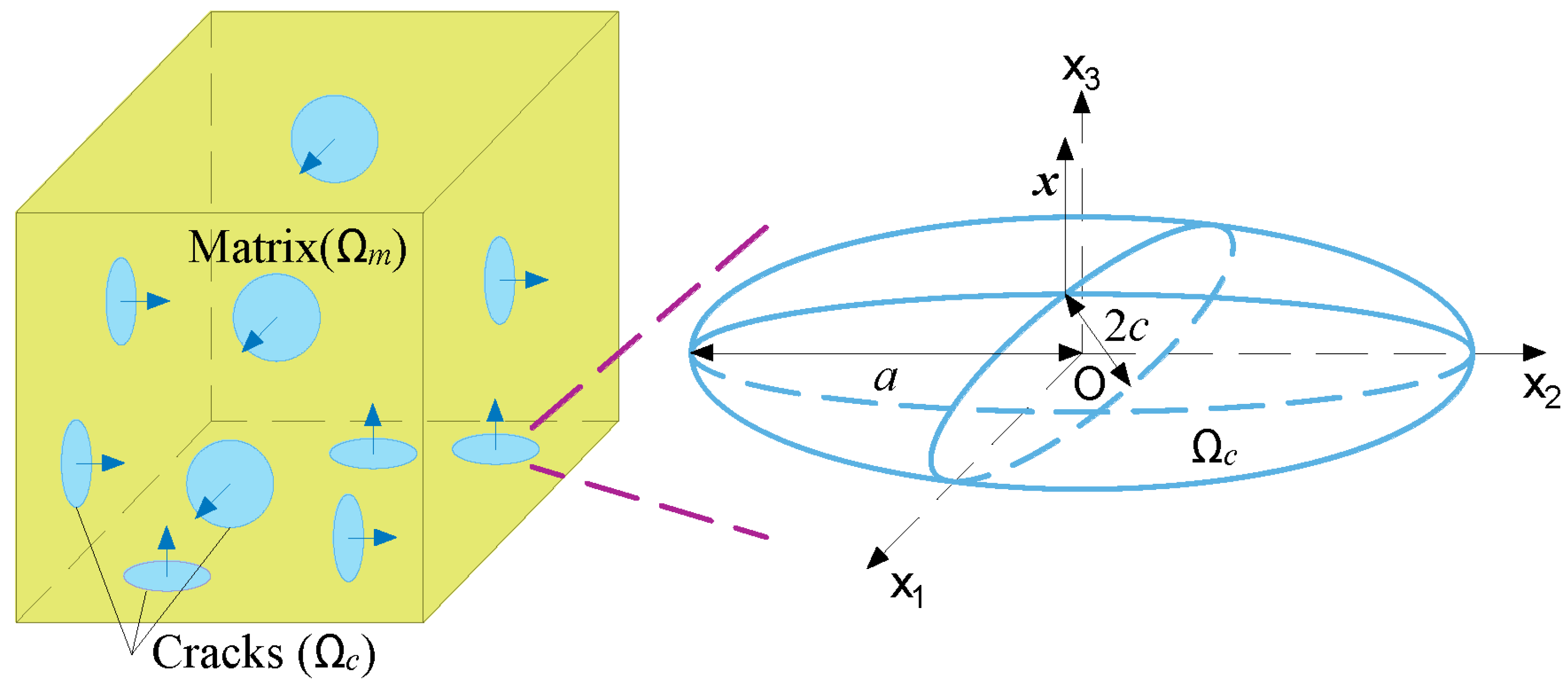
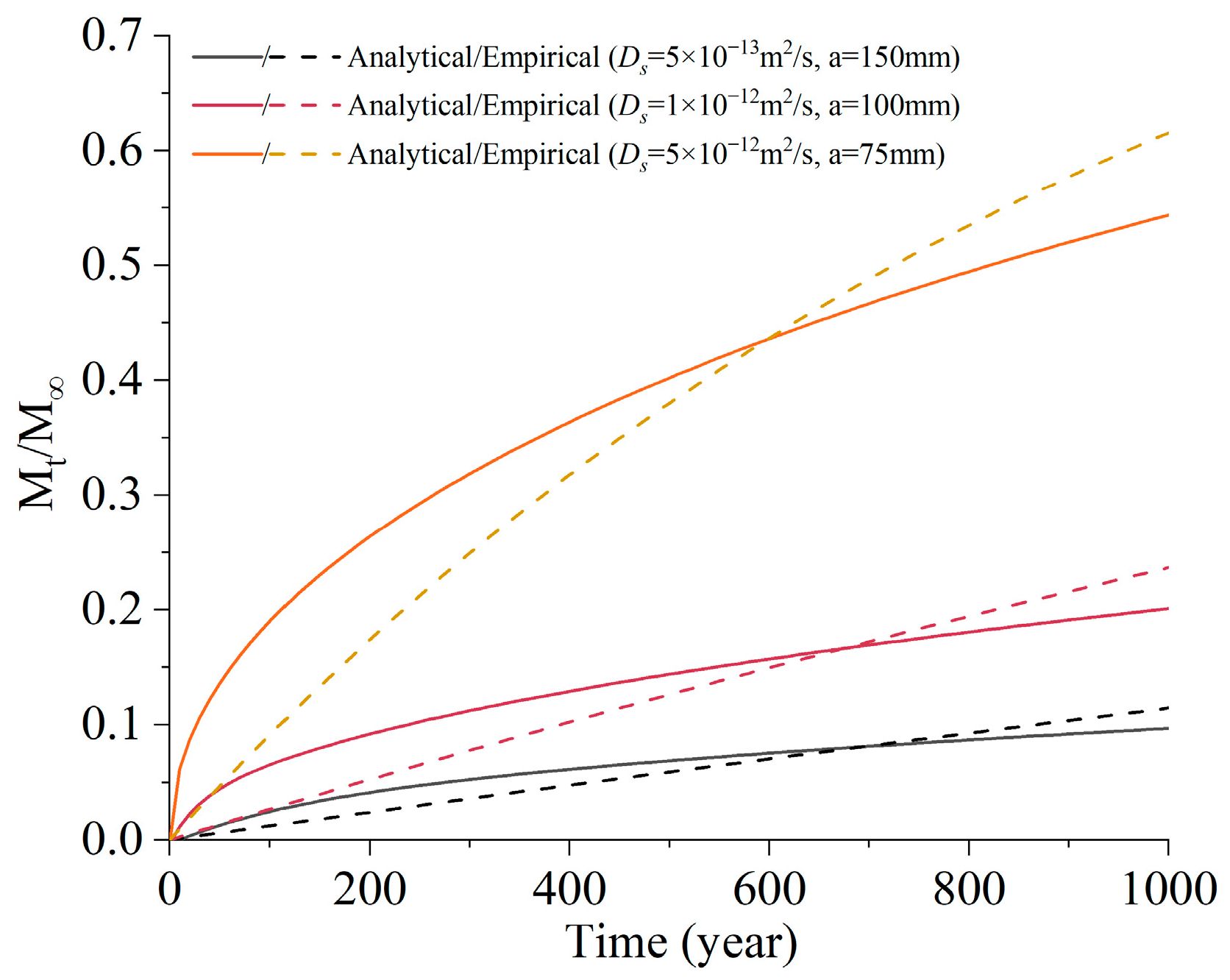
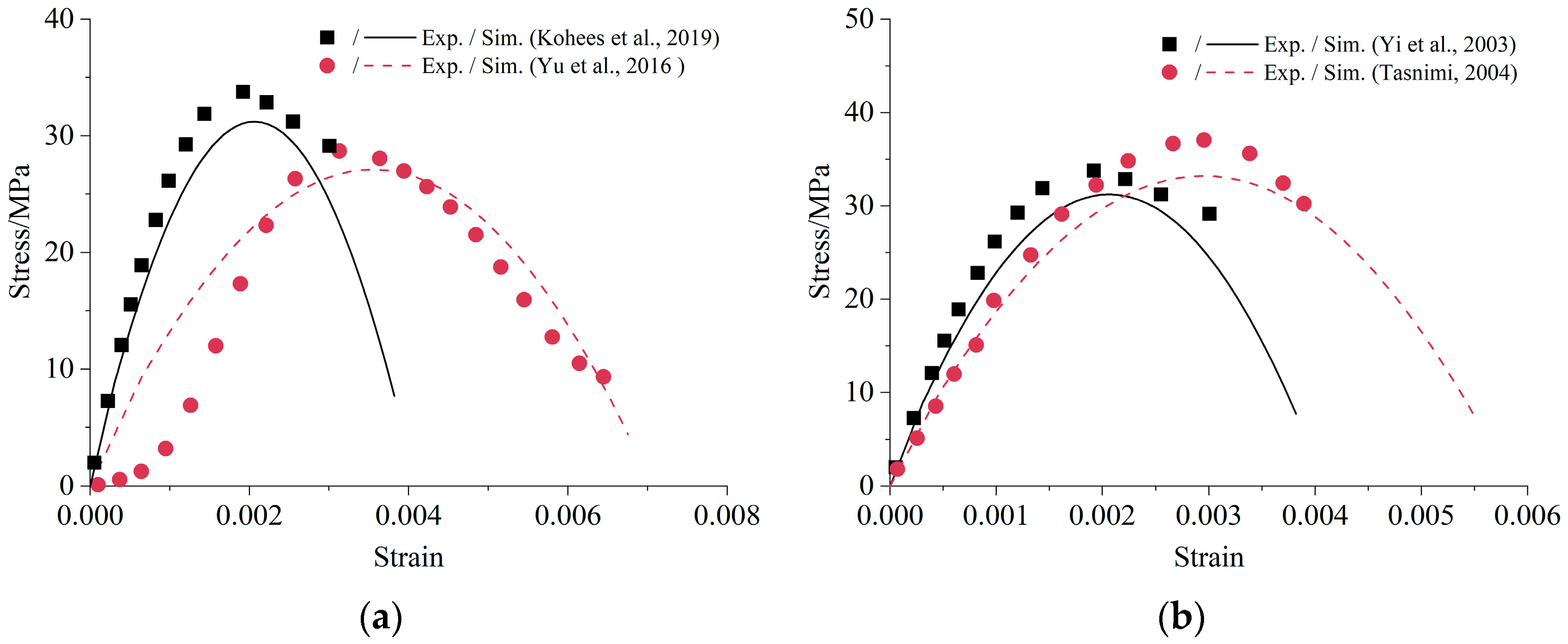
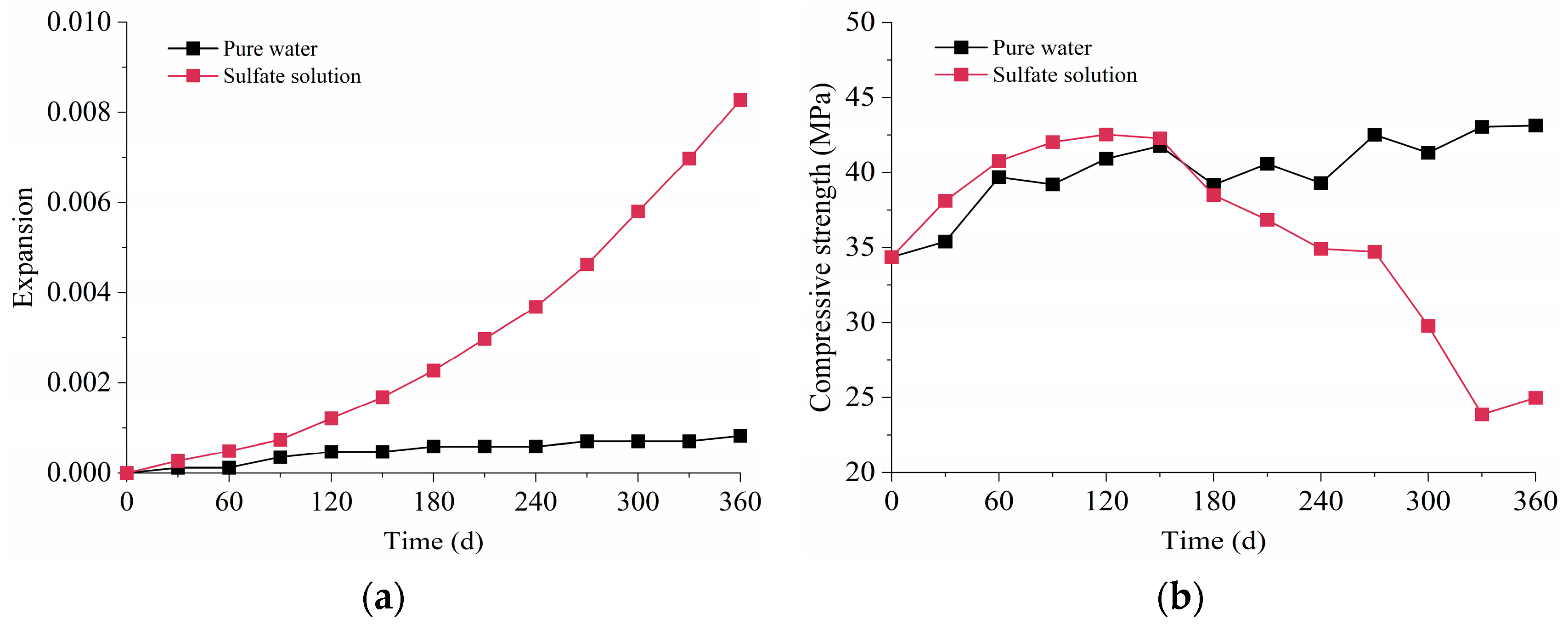

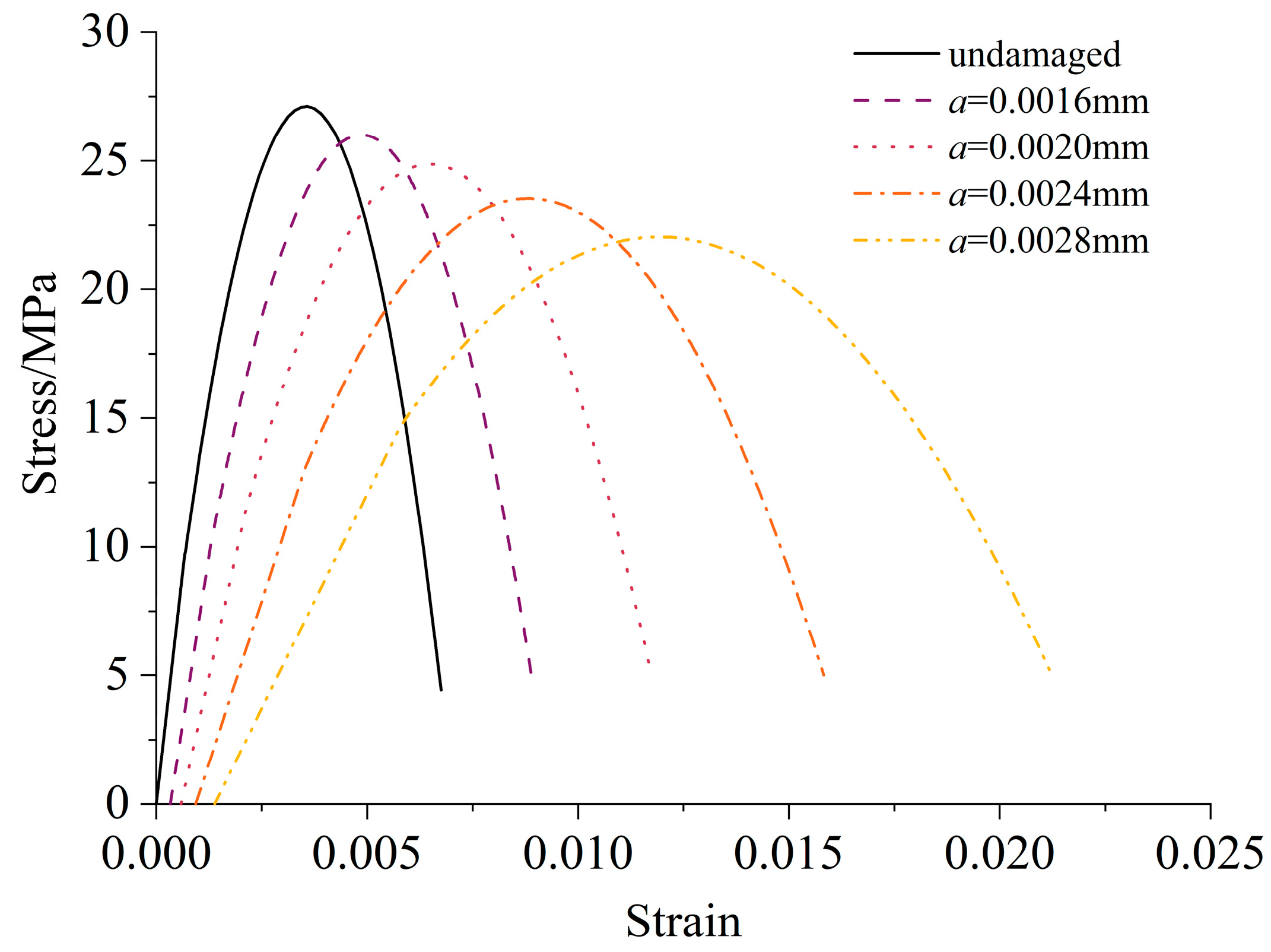
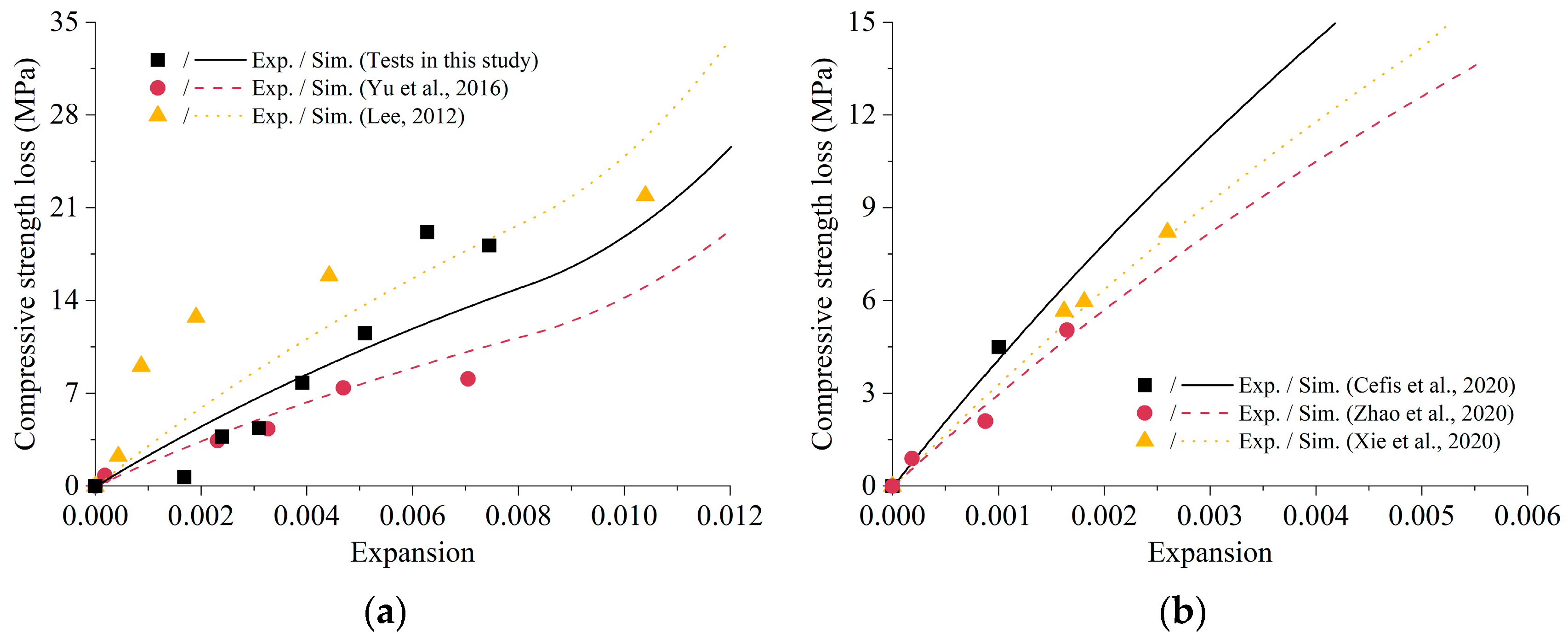
| Kohees et al. [34] | Yu et al. [38] | Yi et al. [39] | Tasnimi [40] | |
|---|---|---|---|---|
| Material | Mortar | Mortar | Concrete | Concrete |
| Yin (GPa) | 23.21 | 14.40 | 28.88 | 21.42 |
| Ym (GPa) | 31.42 | 17.85 | 36.32 | 25.67 |
| σc,in (MPa) | 38.00 | 29.18 | 33.78 | 37.06 |
| εc,in | 3.04 × 10−3 | 2.33 × 10−3 | 1.80 × 10−3 | 1.92 × 10−3 |
| ci (μm) | 0.1 | 0.1 | 0.1 | 0.1 |
| fc,in | 5.14% | 4.06% | 3.92% | 4.21% |
| Xin | 0.075 | 0.090 | 0.060 | 0.093 |
| Gf (N/mm) | 3.19 × 10−7 | 2.73 × 10−7 | 1.27 × 10−6 | 6.38 × 10−7 |
| SiO2 | Al2O3 | Fe2O3 | CaO | SO3 | MgO | Na2O | K2O |
|---|---|---|---|---|---|---|---|
| 19.95 | 4.63 | 2.95 | 61.87 | 2.51 | 2.09 | 0.15 | 0.66 |
| Yu et al. [38] | Lee [45] | Cefis et al. [46] | Zhao et al. [44] | Xie et al. [47] | |
|---|---|---|---|---|---|
| Material | Mortar | Mortar | Concrete | Concrete | Concrete |
| Cement type | PO 42.5 | ASTM Type I | CEMII/A-LL | PC 32.5R | PO 42.5R |
| w/c | 0.4 | 0.45 | 0.45 | 0.486 | 0.45 |
| Corrosion solution | 5% Na2SO4 | 5% Na2SO4 | 10% Na2SO4 | 10% Na2SO4 | 5% Na2SO4 |
| Compressive test | Φ 50 × 100 mm | 50 × 50 × 50 mm | Φ 150 × 300 mm | Φ 100 × 200 mm | Φ 150 × 300 mm |
| Expansion test | 25 × 25 × 285 mm | 25 × 25 × 285 mm | Φ 50 × 110 mm | Φ 100 × 200 mm | Φ 150 × 300 mm |
| Test period | Every month | 91, 180, 270, 360, 450 d | Every two months until 1080 d | 30, 90, 180, 270, 360 d | 28, 91, 154, 217, 280 d |
| Tests in This Study | Yu et al. [38] | Lee [45] | Cefis et al. [46] | Zhao et al. [44] | Xie et al. [47] | |
|---|---|---|---|---|---|---|
| Material | Mortar | Mortar | Mortar | Concrete | Concrete | Concrete |
| Yin (GPa) | 20.06 | 14.40 | 23.35 | 30.28 | 30.40 | 29.25 |
| Ym (GPa) | 24.62 | 17.85 | 29.58 | 34.62 | 36.50 | 40.78 |
| σc,in (MPa) | 34.37 | 29.18 | 47.60 | 30.02 | 30.00 | 25.00 |
| εc,in | 2.75 × 10−3 | 2.33 × 10−3 | 3.81 × 10−3 | 1.66 × 10−3 | 1.66 × 10−3 | 1.47 × 10−3 |
| ci (μm) | 0.1 | 0.1 | 0.1 | 0.1 | 0.1 | 0.1 |
| γ | 0.04 | 0.04 | 0.04 | 0.025 | 0.025 | 0.025 |
| fc,in | 3.61% | 4.06% | 4.16% | 2.67% | 3.58% | 3.11% |
| Xin | 0.082 | 0.090 | 0.081 | 0.075 | 0.094 | 0.098 |
| Gf (N/mm) | 2.99 × 10−7 | 2.73 × 10−7 | 4.87 × 10−7 | 3.78 × 10−7 | 2.91 × 10−7 | 5.08 × 10−7 |
Disclaimer/Publisher’s Note: The statements, opinions and data contained in all publications are solely those of the individual author(s) and contributor(s) and not of MDPI and/or the editor(s). MDPI and/or the editor(s) disclaim responsibility for any injury to people or property resulting from any ideas, methods, instructions or products referred to in the content. |
© 2023 by the authors. Licensee MDPI, Basel, Switzerland. This article is an open access article distributed under the terms and conditions of the Creative Commons Attribution (CC BY) license (https://creativecommons.org/licenses/by/4.0/).
Share and Cite
Li, S.; Yu, X.; Yang, S.; Wang, H.; Chen, D. A Micromechanical-Based Semi-Empirical Model for Predicting the Compressive Strength Degradation of Concrete under External Sulfate Attack. Materials 2023, 16, 5542. https://doi.org/10.3390/ma16165542
Li S, Yu X, Yang S, Wang H, Chen D. A Micromechanical-Based Semi-Empirical Model for Predicting the Compressive Strength Degradation of Concrete under External Sulfate Attack. Materials. 2023; 16(16):5542. https://doi.org/10.3390/ma16165542
Chicago/Turabian StyleLi, Shagang, Xiaotong Yu, Shanyin Yang, Hongxiang Wang, and Da Chen. 2023. "A Micromechanical-Based Semi-Empirical Model for Predicting the Compressive Strength Degradation of Concrete under External Sulfate Attack" Materials 16, no. 16: 5542. https://doi.org/10.3390/ma16165542
APA StyleLi, S., Yu, X., Yang, S., Wang, H., & Chen, D. (2023). A Micromechanical-Based Semi-Empirical Model for Predicting the Compressive Strength Degradation of Concrete under External Sulfate Attack. Materials, 16(16), 5542. https://doi.org/10.3390/ma16165542






